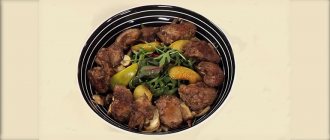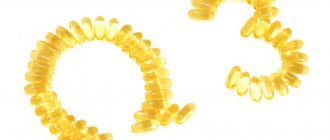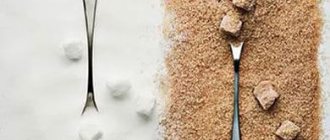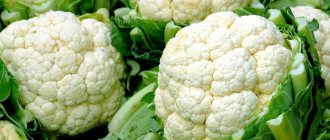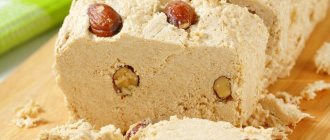Liver is a controversial product in children's diets. Some consider such food to be tender, dietary and healthy. Others are sure that it is dangerous for a small child. But this by-product contains an increased amount of useful proteins and amino acids, vitamins, minerals and other important elements.
When properly prepared, it has a beneficial effect on the body. However, it is important to introduce the product into the diet of children in a timely manner. Let's figure out at what age you can give beef liver to a child.
Properties of liver as a component of baby food
You need to be careful when introducing a new product into a child’s diet: first, you should choose one recipe for a liver dish as complementary food, find out how many grams of liver should be included in this dish, and then gradually complicate the child’s diet with new products and dishes.
Pediatricians advise giving liver to newborns when they are less than a year old - from the age of seven months. Up to a year, it is added to food once a week, and then gradually made a stable product of the child’s diet.
Pediatricians advise giving liver to newborns when they are less than a year old - from the age of seven months. Up to a year, it is added to food once a week, and then gradually becomes a stable product of the child’s diet.
It is recommended to introduce various types of liver into complementary foods, complementing each other in the content of useful components: cod, chicken, rabbit and turkey liver.
Cod liver
Cod liver, which is ahead of other types on the scale of beneficial properties, is suitable for seven-month-old children.
- Vitamin D, richly presented in it, protects the child’s body from rickets;
- Vitamin A improves hair health, strengthens teeth and reduces the risk of skin diseases;
- The list of mineral components beneficial for children includes zinc (Zn), iodine (I) and calcium (Ca). They strengthen the musculoskeletal system of the newborn and create a protective barrier against infections;
- The benefits of this fish delicacy also extend to the cardiovascular system, helping to strengthen the heart muscle and normalize blood flow.
Poultry liver
In the fight against infectious diseases, chicken and turkey liver, which contains folic acid, is an active participant. At first, its use will help support the child’s vision and strengthen the respiratory system. Once young children learn to walk, they spend a lot of energy because they are constantly on the move. The protein contained in chicken liver will help replenish energy costs.
Beef liver
Another useful type of liver is beef, which supplies the child with vitamin B. Its benefits extend to the central nervous and circulatory systems of the body. It is recommended to give dishes from this product to newborns to reduce the risk of infectious diseases and normalize hemoglobin levels.
Pork liver
Among the variety of types of liver products included in complementary foods, you should be wary of pork liver. Nutritionists do not recommend giving dishes made from this product to children due to its difficult digestibility.
A wide range of nutritional supplements for newborns saves time and effort on cooking. But you can’t skimp on the benefits for the child - natural products should be regularly included in food for the following reasons:
- they accustom the child’s body to more complex foods;
- they contain natural vitamins and mineral components that differ from the composition of baby food.
In what form to give
When introducing liver into complementary foods, the mother can prepare monocomponent puree herself or buy ready-made in jars (for example, “Heinz”, “Babushkino Lukoshko”). Ready-made baby food has a number of advantages, but many parents consider the first option to be the most preferable in terms of benefits and safety.
Pork liver is quite quick and easy to prepare. It can be steamed, stewed, fried, boiled. The offal is combined with vegetables, cereals, pasta, it can be used as a filling for pies and pancakes, and can be used to make quenelles, cutlets, and pate.
Beneficial properties of chicken liver
Chicken liver has a low calorie content and contains a list of biological substances important for the body. This explains the fact that experts often include this by-product in various diets. It is worth noting that even irregular consumption of this product will give you the opportunity to feel its beneficial properties.
Chicken liver has a stimulating effect on metabolic and hematopoietic processes, helps stimulate the strengthening of bones and muscle fibers, normalizes sleep, reduces the risk of problems with the cardiovascular system, has a normalizing effect on the gastrointestinal tract, and stimulates the immune system.
For women
As for the benefits of chicken liver for a woman’s body, its properties are very extensive:
- The by-product has beneficial properties for the condition of the skin, hair, teeth and nails. Thanks to the beneficial substances that make up the liver, its regular use will significantly affect a woman’s appearance.
- Thanks to riboflavin, which is found in abundance in chicken liver, the fair half can easily help prevent anemia and avoid harm from this disease. Eating chicken liver 3 times a week will be enough to reap the benefits.
- We must not forget about folic acid, which is necessary for pregnant women. Its deficiency can cause harm during the formation of the embryo.
- Women who follow low-carb diets can safely consume liver. The benefits of chicken liver for women on a diet are invaluable. It contains many useful substances to improve performance and prevent possible harm from poor nutrition.
- Iodine and selenium are also contained in this product. They are necessary for the normal functioning of the thyroid gland, which so often worries women.
For men
- The offal contains pantothenic acid, which is very beneficial for men. She is responsible for the full functioning of the adrenal glands, which regulate the function of conception.
- It is required for men who are regularly physically active. Promotes muscle building and rapid physical recovery.
- In addition, the by-product extends beneficial properties to potency. The product is able to increase blood flow, including in the penile area, which increases sexual activity. This helps not only enhance male libido, but also fertility.
Chicken liver – how much can you give it?
I wouldn't give chicken at all. They say that someone has visited poultry farms and seen how these chickens are raised and fed - they don’t eat chicken in the future. And I myself noticed that these chickens (even though they are fresh) stink of some kind of steroids (in my opinion). And the liver is the filter of the whole body. Just think about how much she has already filtered out, our pediatricians generally tell mothers: write a poster at home and a story in the kitchen LIVER-POISON so that it doesn’t even occur to you to feed your child with it. This idea seemed to me not devoid of common sense and I accepted it. And you decide for yourself. At least don't get carried away with it.
I wouldn't give chicken at all. They say that someone has visited poultry farms and seen how these chickens are raised and fed - they don’t eat chicken in the future. And I myself noticed that.
Tatiana
Another horror story. If you know everything about everything, then you can definitely get sick with something. I’m telling you this, as a commodity expert. But the liver still contains useful substances. Who could name at least one product bought in a store that can be safely consumed?
On the topic: We are almost a year and four years old, I give him liver, he eats poorly, I don’t insist. I cook with veal, we love the liver very much.
Tatiana
Another horror story. If you know everything about everything, then you can definitely get sick with something. I’m telling you this, as a commodity expert. But there are still some useful things in the liver.
There are useful substances in the liver - but they are stored only in the paired liver, for 12 hours after. the end of the life of a bird or animal. and what comes to our table, and even in frozen form, has very little useful, so it is a purely tasteful product. Сoccinella
I agree with you: living is generally dangerous. It’s just not safe to live. And breathing the air of a large city is almost the same as some kind of poisonous miasma.
There are useful substances in the liver - but they are stored only in the paired liver, for 12 hours after. the end of the life of a bird or animal. but what gets there.
From what months can you give your baby chicken liver?
At what age can a child be given offal products such as April 16, 2007
What will it look like? Country of Mothers → At what age can children have SalO? My daughter suddenly fell in love with lard, it’s strange, she’s only 2.5 years old and suddenly this happens. I know in our city, my sister gave her one-year-old brother a piece and his liver collapsed.
At what age can a child be given dry foods? At what age can a child be given dry foods? I don’t dry it at all. They are small and a baby could choke on them. I started giving bagels from 5 months at 79. As soon as the teeth grow, I don’t know...
But I think that regular cookies, fresh ones like Yubileiny, can already be given to a baby for about a year. Complex cookies (with additives) are not recommended for children under 3 years old.October 16, 2013
Tell me, from how many months can a baby be introduced to... Tell me, from how many months can a baby be introduced to complementary foods with cottage cheese and milk? Children's curds are much earlier, and milk is recommended from 2 years old, it contains heavy protein. I'll tell you about us. baby food…
So, when can you introduce the liver? Maybe just boil it longer and drain the broth, then you can feed the child? on jars like from 8 months. We started a little later and are still cracking it. I give you chicken. April 28, 2012
At what month did you start giving apple juice to your... At what month did you start giving apple juice to your baby? And what’s the first porridge? Is FRISO porridge good? I started giving juices at 9 months, I buy Heinz - they are without...
68 answers to the question “What vegetables can be given to a baby and from how many months?” And from 3 months she began to give a little bit of pureed chicken fillet (breast). Is it possible to give a 3 month old a banana?
When can a child be given milk porridge? I started giving liver at 10 months. I gave it chicken after a year. A year later, he put the animals in the house with me, he could insert the figures into the holes himself, but with animals it was more difficult... April 7, 2011
Please tell me who gives the reb. liver gov. Since how many months? January 27, 2010
To the section Family, Home, Children. Answer the question: At what age can children be given chewing gum? At what age can children be given liver (rabbit, chicken, beef)?
Our children. Baby food. Can a child of 11 months eat chicken liver and chicken hearts? I ground the hearts with potatoes. we are 11 months old. Do you think it’s possible at this age? Since when did you put hearts in soup?
Beef liver in medicine
For diabetes
For diabetes mellitus, it is allowed to add beef liver to the diet. This is due to the high content of vitamins and elements, the most important of which are copper and iron. Here they are contained in an active form, due to which they are easily absorbed by the human body. Iron helps ensure normal hemoglobin levels, and copper protects against the development of inflammatory processes. In addition, the vitamins and minerals contained in the liver protect the skin, brain and excretory system organs in diabetes mellitus.
For pancreatitis
To protect against exacerbations of gastrointestinal diseases, namely pancreatitis, it is important to follow a diet. This will make periods of remission longer
The basis of nutrition in such cases should be foods containing a lot of protein, vitamins, and enzymes. It is worth noting that foods containing fats and carbohydrates have a negative effect on the digestive tract.
During exacerbations, liver consumption should be avoided. This is due to the fact that it increases the secretion of gastric juice, which negatively affects the inflamed areas of the digestive organs. It is necessary to introduce cow liver into the diet gradually, and should begin a month after the onset of the remission period. This will restore the functioning of organs, and due to the large vitamin composition, improve a person’s well-being.
For gastritis
With gastritis, the body does not absorb a sufficient amount of useful and nutrients. Beef liver has a high level of essential nutrients for humans, which is necessary for people suffering from gastritis. However, if gastritis is associated with an increased level of acidity, consuming liver is not recommended. This is due to the fact that the extractive elements present in it, which contribute to the production of hydrochloric acid, lead to irritation of the walls of the stomach. You should not use liver during exacerbation of gastritis. As for gastritis with low acidity, there are no restrictions regarding beef liver.
For constipation
Beef liver helps combat problems such as constipation. By normalizing digestion, in particular improving the functioning of the gastrointestinal tract, taking this offal eliminates constipation. At the same time, peristalsis is restored, as well as intestinal microflora. This helps protect the human body from the development of intestinal obstruction.
For gout
Comprehensive treatment of gout also involves following a strict diet. It is impossible to completely get rid of this disease, but by following a special diet you can reduce the period of exacerbations. Beef liver can be included in the diet of a patient with gouty arthritis, but it must be remembered that the fresh product is most beneficial. Beef offal should be consumed in limited quantities, no more than 1-2 times a week. As mentioned above, beef liver contains a lot of iron, folic acid and B vitamins.
For cholecystitis
As you know, inflammation of the gallbladder occurs due to poor nutrition. Therefore, a rational diet is important in the treatment of this disease. If you have cholecystitis, you should eat foods rich in vitamins, nutrients, dishes that are easily absorbed by the body, have a low calorie content and help dilute bile. Beef liver meets these requirements. It can be included in the diet for such pathologies, but the method of processing this product is very important. For this, liver dishes cooked steamed or in water, without adding spices, are best suited.
We recommend reading:
When can you give liver?
So is it even possible for children to have liver? Based on all of the above, it is possible to give liver, as they say, but carefully. At what months can a baby have a liver? It is better to introduce this by-product into the baby’s diet after he has started eating meat and has become accustomed to this taste.
That is, we keep the target for approximately 9 months. This is, if we talk about pediatric complementary feeding, which is aimed at gradually replacing breast milk in the baby’s diet with “adult” dishes
It is better to introduce this by-product into the baby’s diet after he has started eating meat and has become accustomed to the taste. That is, we keep the target for approximately 9 months. This is if we talk about pediatric complementary feeding, which is aimed at gradually replacing breast milk in the baby’s diet with “adult” foods.
How much liver can a child receive during pediatric complementary feeding? The first portion is no more than half a teaspoon. By the year it can be no more than 60 grams. And given that most types of offal, in addition to protein, contain a lot of fat, it should appear in a baby’s diet no more than 2 times a week.
Pedagogical complementary feeding is no less convenient and simple in its concept. Its essence is that the baby receives new foods solely for the purpose of becoming familiar with the dishes that his parents eat. This usually happens a little earlier than 9 months (around six months), when the child develops a natural interest in food. At the same time, he is given a tiny piece of the product. With pedagogical complementary feeding, the liver for children under one year old will not cause harm, but will give the baby a new taste.
How to properly introduce complementary foods, in what order to introduce new foods and how to maintain your baby’s appetite, see the online course ABC of complementary feeding: safe introduction of complementary foods to infants>>>
From how many months can you give it?
You can introduce a child to this type of offal, such as liver, before the age of one. It is recommended to start introducing complementary foods after the child has tried meat dishes and got used to them. Most children can be offered it for the first time at 8-9 months. At first, the product is simply boiled and thoroughly ground until a homogeneous and not too thick consistency is obtained.
For a one-year-old child, soufflés, pates, casseroles, soups, puddings and other dishes are prepared from the liver. When the baby learns to chew well, he can be treated to stewed and oven-baked liver, and dishes made from such a product, for example, liver pancakes, are given no earlier than 3 years of age. As for the question of what to give liver with, this product is often combined with vegetable dishes. It can also be supplemented with a cereal side dish.
Calculate your complementary feeding table
Beef liver recipes
Quinoa salad
- Beef liver – 0.3 kg;
- Quinoa – 100 grams;
- Bell pepper – 3 pcs.;
- Fresh cucumbers – 2 pcs.;
- Lettuce leaves – 100 grams;
- Garlic – 2 cloves;
- Olive oil – 3 tables. spoons;
- Lemon juice – 2 tables. spoons.
Quinoa has become a very popular food today. It is a healthy cereal that does not contain gluten and is optimally suited for proper nutrition, diets and people with food allergies. Quinoa is widely used for preparing restaurant dishes, but it is also perfect for home cooking.
Rinse the quinoa, pour a glass of boiling water and cook for twenty minutes. Separately mix olive oil, lemon juice and chopped garlic. Add pepper and salt to taste. Cut the pepper into halves, peel and grease with the resulting sauce, bake for ten minutes at a temperature of two hundred degrees.
Wash the liver, cut into strips and fry until cooked. Peel the cucumbers and also cut into strips. Wash the lettuce leaves, dry them and tear them with your hands. Mix lettuce, cucumber, quinoa and liver. Season with the remaining sauce and place in the roasted pepper halves. Or cut the peppers into strips, add to the salad and serve the dish traditionally in a salad bowl or portioned plates.
In sour cream sauce
- Beef liver – 0.5 kg;
- Flour – 5 tables. spoons;
- Onion – 1 pc.;
- Sour cream – 250 gr.;
- Vegetable broth – 250 ml.
Liver goes well with sour cream, so recipes often contain a similar combination of components. We clean the liver from films, wash it, dry it and cut it into cubes. Season the pieces with salt and pepper to taste, roll in flour and fry on each side for two to three minutes. Set the liver aside.
Peel the onion and cut into half rings, lightly fry, add the remaining flour. Pour in the broth and sour cream, stir, add salt, pepper, garlic or other spices if necessary. Add the liver and simmer for about half an hour. Serve the finished dish with boiled rice, buckwheat or mashed potatoes.
Baked Potato
- Potatoes – 0.4 kg;
- Beef liver – 200 grams;
- Sour cream 10% – 100 grams;
- Onion – 1 pc.
Wash the liver and cut into pieces. Peel the onion and cut into rings. Lightly fry in a frying pan, add liver, pour in sour cream and simmer for 30 minutes. Peel the washed potatoes and cut into slices. Place the potatoes on a baking sheet greased with sunflower oil. Salt and pepper to taste. Spread sour cream with liver on top and bake for forty minutes at 180 degrees.
Pancakes
- Beef liver – 0.5 kg;
- Flour - 2 tables. spoons;
- Eggs – 2 pcs.;
- Onion – 1 pc.;
- Sour cream – 1 table. spoon.
Peel the onion and cut into halves or quarters. Wash and dry the liver, cut into pieces and grind together with the onion in a meat grinder. Break the eggs into the resulting minced meat, add flour and sour cream, salt and pepper to taste. Mix the mass. Form pancakes and fry on both sides until cooked.
Beef liver pancakes served with sour cream. They will be a suitable solution for breakfast. If you are using liver fritters as a second course for lunch, serve with a side dish. They are combined with fresh vegetables, buckwheat, rice or mashed potatoes.
Rice casserole
- Beef liver – 0.4 kg;
- Rice – 0.4 kg;
- Eggs – 1 pc.;
- Milk – 100 ml;
- Carrots – 1 pc.;
- Onion – 1 pc.;
- Garlic – 2 cloves;
- Dill – 1 bunch;
- Butter – 2 pieces.
Wash the rice and cook until done. Clean the liver from films, rinse and dry, and grind in a meat grinder. Prepare the vegetables, cut the onion into cubes, grate the carrots and finely chop the garlic. Fry the ingredients with a piece of butter. Mix rice with liver and fried vegetables, add salt and pepper to taste.
Subscribe to our VKontakte group
Which one is better to choose for baby food?
There are several types of liver and each has its own benefits for inclusion in a child's diet.
You can offer your baby the following liver:
- Beef or veal. It is recommended to start complementary feeding with liver, since such a product is digested very easily and rarely causes allergies. Beef liver has a high content of vitamin A and B vitamins, as well as low calorie content. Its use maintains hemoglobin at a high level and increases the body's defenses. The disadvantages are some harshness and the need to spend time cleaning the bile ducts and films.
- . Its advantages include soft consistency and pleasant taste. In addition, it is prepared for cooking and cooks faster than other types of organ meats. This product is rich in iron and folic acid, therefore it has a positive effect on immune function and hematopoiesis. It also contains a lot of choline, which has a beneficial effect on the child’s nervous system and brain activity.
- Pork. This type of liver is quite tender and loose in consistency, and the calorie content of the product is low. In addition, it cooks quite quickly, and it does not have hard films. However, this by-product also has disadvantages, including a slightly reduced content of nutrients, as well as the frequent presence of a bitter taste in ready-made dishes. However, children receive iron, copper, manganese, vitamins A, E, group B, cobalt, iodine and many other substances from pork liver.
- Turkey. Like chicken, turkey liver is easily digestible, cooks quickly, has a delicate structure and pleasant taste. At the same time, it is quite high in calories due to its high fat content (it contains almost twice as many calories as beef, pork or chicken). From it the child will receive vitamins B12, K and C, selenium, iron, phosphorus, chromium, vitamin PP and many other valuable compounds.
- A rabbit. This product contains many vitamins and minerals, including beta-carotene, calcium, tin, selenium, vitamin D, cobalt, vitamin K, choline and others. The only drawback of this tasty type is its high cost. In addition, it is found on sale much less often than chicken, pork or beef liver.
- Codfish. This delicious product is rich in vitamin A, zinc, iodine, vitamin D and calcium. Its use will help prevent rickets, skin and dental diseases, as well as strengthen bones and protect the baby from infections. Such a liver is also very useful for the condition of the cardiovascular system.
Benefits of the liver
Pork liver contains many useful substances:
- vitamin A;
- B vitamins (B1, B2 B5, B9, B12);
- vitamin C;
- vitamin E;
- vitamins PP and H;
- omega-3 and omega-6;
- magnesium;
- potassium;
- phosphorus;
- chlorine;
- iron;
- sodium;
- iodine;
- sulfur;
- zinc;
- calcium;
- selenium;
- manganese;
- cobalt;
- copper;
- molybdenum.
The value for the body is as follows:
- Pork liver is an excellent source of protein. The amino acids in their composition (8 essential and 10 non-essential) are important for the construction and growth of tissues, as well as maintaining the normal functioning of internal organs.
- B vitamins and iron are involved in the formation of red blood cells, hemoglobin, are necessary to ensure the smooth functioning of the nervous system, and normalize sleep.
- A large amount of vitamin A helps maintain vision, and in combination with other elements gives strength to teeth, bones, and improves the condition of hair and nails.
- Pork liver contains a lot of copper, which stimulates metabolism, insulin production, is involved in hematopoiesis, and helps iron be absorbed. Important for brain cells. Helps protect the body from harmful substances.
- Vitamins E and C help the body protect itself from the negative influence of the environment, get rid of toxins and waste, and are important for strong immunity.
- The activity of vitamins E and C is enhanced by selenium. It itself is a powerful antioxidant. Selenium is also needed for the production of red and white blood cells, some hormones and enzymes.
Many parents mistakenly believe that pork liver is difficult to digest because it is fattier than the liver of other animals. That's why they are afraid to give it to children. However, this opinion is not confirmed by facts, because the nutritional value is as follows:
- calorie content: 130 (kcal);
- proteins: 22 g;
- fat: 3.4 g;
- carbohydrates: 2.6 g.
What can you cook?
Many mothers of babies are faced with the difficulty of making something so tasty from chicken liver. Many “adult” dishes are simply not suitable for children, as they include ingredients that are contraindicated for children. When creating a children's menu, be sure to take into account the age of the child. For example, young children should not use too many spices when preparing dishes. These substances can be irritating to the stomach, which often contributes to the development of indigestion in children.
Dishes where chicken liver is well chopped are suitable for babies. These include:
- various soufflés;
- pates;
- cutlets;
- soups with meatballs made from minced chicken liver.
For children who can already chew, you can prepare dishes containing individual pieces of chicken by-products. Chicken liver must undergo heat treatment
It is very important to cook or stew it thoroughly. If the temperature treatment process is carried out incorrectly, this can lead to negative consequences for the child’s body.
Checking the readiness of chicken liver is quite simple. To do this, when cooking offal, simply pierce it with a fork or knife and look at the color of the juice that will flow out. If it is transparent, then the product is cooked well enough. If a reddish liquid leaks out, then the chicken liver should be cooked for a few more minutes.
The method of preparing offal is also important. Dishes prepared by boiling or stewing are more suitable for children.
Fried liver dishes can be included in a child’s diet only after three years of age. If possible, the amount of fried food in the baby's diet should be minimal.
Some children aged 2-3 years may experience problems with stool when consuming large amounts of protein foods, including chicken liver. To prevent this from happening, the liver should be combined with various vegetables. Such dishes will be more beneficial for the child’s body, and will also help normalize the child’s digestion.
Recommendations for selection and storage
The best option is to purchase chilled liver in trusted places. This will minimize the risk that you will receive a low-quality product.
Before making a choice, you need to carefully examine the pork liver. A good product is brown in color, without stains, and its surface is smooth and glossy. If you press a little on the liver with your finger, a hole will appear, which will immediately disappear (the liver should be elastic). Also pay attention to the smell: if it is pleasant and sweetish, then the product is fresh, if it is unpleasant and sour (or sharp), it is better to refuse the purchase.
Chilled liver can be stored in the refrigerator for up to 2 days; if longer storage is required, it is better to freeze it immediately.
Chemical composition of chicken liver
Chicken liver is the leader among other food products in iron content - about 17.5 milligrams of this substance per 100 grams of product. The calorie content of chicken liver per 100 grams is about 140 kcal. Chicken liver contains vitamins, and therefore its benefits for the body are enormous, including:
- folic acid, which is so necessary for women planning and expecting a child;
- ascorbic acid, which maintains energy levels and improves immunity;
- riboflavin, carotene, thiamine and niacin - these vitamins are required for the normal functioning of all body systems.
In addition, chicken liver is beneficial because it contains a whole list of minerals, including:
- cobalt;
- molybdenum;
- chromium;
- copper;
- phosphorus;
- potassium;
- sodium;
- magnesium;
- calcium.
Composition and calorie content
Despite the fact that 70% of the liver’s mass is water, it contains a lot of useful substances - vitamins, proteins, minerals, amino acids in a form that is easily digestible for the body.
100 g of offal contains:
- 18 g of proteins, including essential, (not produced in the body) and non-essential amino acids;
- 5.3 g carbohydrates;
- 3.7 g fat.
In addition, beef liver contains:
- polyunsaturated (omega-6 and omega-3, linolenic, arachidonic, linoleic) acids that are very beneficial to the body;
- monounsaturated (omega-9 and palmitoleic);
- saturated fatty acids (stearic, palmitic, myristic).
Huge reserve of minerals in the liver:
- iron;
- phosphorus;
- potassium;
- selenium;
- calcium;
- zinc;
- magnesium;
- sodium;
- iodine;
- chlorine;
- fluorine;
- molybdenum;
- sulfur;
- manganese;
- chromium;
- nickel;
- copper;
- cobalt.
The vitamin composition is also quite rich: PP, K, H, beta-carotene, niacin, almost the entire group B (B1, B4, B6, B2, B5, B12, B9).
The content of some vitamins in 100 g of liver is very significant compared to the daily requirement of a child:
- the amount of vitamins D and A is equal to 5 daily requirements;
- vitamins B6 and B4 – ½ norm;
- vitamin B2 – 1.5 norms;
- vitamin PP – 2/3 of the daily requirement.
The calorie content of 100 g of liver depends on the method of its preparation:
- in the oven or steamed – 126 kcal;
- boiled - about 115 kcal;
- fried (not recommended for children under 7 years old) – 199 kcal.
Is chicken liver good for children?
The benefits of chicken liver are also relevant for children. It has many beneficial properties for babies. It is a source of protein and contains all the most important amino acids for a child’s body, even those synthesized in the human body. In addition, by consuming the offal, the child receives a lot of vitamins, including:
- vitamins A, D, PP, B12;
- folic acid, which is responsible for the synthesis of DNA and RNA cells and the production of the hormones dopamine and serotonin;
- choline, which has beneficial properties for the nervous system, memory and brain activity.
In addition, it is useful due to the content of vitamins B2, E, C, B1, B6, calcium, iron, magnesium, selenium, copper and many other elements that are most valuable for children's health. Eating liver will help prevent anemia and ensure the full development and growth of the child. A separate advantage is the speed of cooking chicken liver.
Important! To obtain all the beneficial properties and avoid harm to the baby, it is extremely important to choose the right chicken liver. Contraindications:
Contraindications:
- Since chicken liver contains a large amount of protein, it is not advisable to introduce it into the diet of children with kidney problems, so as not to harm the fragile body.
- Allergic reactions to the product are possible, so when introducing it into the diet, it is necessary to monitor the baby’s condition to prevent harm.
- Low-quality or expired products can also cause harm, so it is necessary to choose them responsibly.
At what age can a child be given chicken liver?
The first time you can give your baby liver is at the age of 8–9 months, after meat has been introduced into the diet. Before giving chicken liver to your child, it is recommended to offer beef or veal liver.
It is important to properly boil and wipe the product. It is necessary to ensure that the consistency of the product is loose and homogeneous.
It is better to combine it with cereals or vegetables. It is better to stew or bake it no earlier than the baby is one year old, and it is necessary to focus on the number of teeth and chewing skills. Fried chicken liver is not recommended for children under 3 years of age, so as not to harm the child’s delicate stomach.
How to cook chicken liver for a child
For children under one year of age, it is better to boil chicken liver and then make a puree from it. The cooking time will be from 10 to 15 minutes. For children over one year old, you can prepare many other equally healthy liver dishes: soups, cutlets, soufflé. The menu for children over 2 years old will be wider. They are already allowed to give chicken liver baked in the oven.
Interesting facts about beef liver
- Beef liver is very popular among athletes and bodybuilders. This is due to the fact that this product helps build muscle mass. So, back in the last century, American scientists conducted an experiment. To do this, they organized three groups of rats, each of which was given a specific menu. Then the experimental animals were placed in containers with water and the time during which the rats stayed afloat was recorded. Rats fed a normal diet swam for 10–12 minutes. Animals whose diets were supplemented with synthetic vitamins lasted a little longer, but the difference was only a few seconds. And rats that ate beef liver could stay on the water for up to an hour and a half. This suggests that this product contains substances that increase endurance, but scientists have not been able to find out which components are responsible for this.
- In some modern civilizations, traditional healers believe that beef liver in its raw state has a large number of useful elements and can relieve various diseases. To do this, the liver is cut into small pieces (the size of a pea) and kept in the freezer for two weeks. For treatment and prevention, such doctors advise taking one such pill every day. It is believed that during their stay in the freezer, all parasites and dangerous organisms die. However, for such experiments only fresh product is used, and animals must be raised in environmentally friendly places and only on a natural diet.
- In the media and in various literature you can find information that the liver of an animal is very harmful, since it is the liver that is primarily exposed to the effects of toxic substances in the body. However, it is worth noting that the liver does not accumulate poisons that enter the body. In addition, this organ collects all nutrients, vitamins and minerals, which, on the contrary, neutralize all toxins.
“Important: all information on the site is provided for informational purposes only. Before applying any recommendations, consult with a specialized specialist. Neither the editors nor the authors are responsible for any possible harm caused by the materials.”
How to choose beef liver
It is better to buy chilled rather than frozen offal to make it easier to assess its quality and freshness.
Regardless of the place of sale (in a store or on the market), the seller, at the buyer’s request, is required to present a certificate for the product and a veterinarian’s report.
- The color of quality beef liver should be burgundy or light brown.
- The film should fit tightly to the liver; there should be no growths or damage on the surface.
- The structure must be uniform.
- The smell is of no small importance for assessing quality: it should be specific, but not repulsive, which appears when the product spoils.
If there is any discrepancy with the listed requirements, you should not buy such an offal.
The liver cannot be stored for long periods of time; toxins accumulate in it. When refrigerated (in the refrigerator), it can be stored for no longer than 2 days, in the freezer - up to 3 months.
Delicious recipe
You can prepare a huge variety of dishes from chicken liver that will not only be tasty, but also healthy for your baby. One of them is casserole. To prepare this dish you will need:
- chicken liver - 300 gr.;
- egg - 1 pc.;
- butter - 40-60 gr.;
- sour cream - 1.5 tbsp. l.;
- salt (to taste).
First you should grind the liver using a blender or food processor. Next, break the egg into the resulting minced meat, add sour cream and salt to taste. The baking dish is greased with butter, and then the finished mixture is poured into it.
Bake the casserole until done at an oven temperature of 170-180 degrees. It’s easy to check the readiness of the casserole - use any wooden stick or skewer to do this. Use a skewer to pierce the casserole. If no reddish liver mixture remains on it, then the dish is ready. It is best to serve liver casserole with vegetable salad or boiled rice.
To learn how to cook chicken liver for a child, watch the following video.
Chicken liver is much more tender and softer than beef or pork. The product has a pleasant taste and belongs to the category of dietary
It is quick to prepare and very healthy, so we decided to discuss why it should be included in the diet of babies, how it will affect their health and what precautions should be taken to avoid allergies and other problems
Liver dishes for children
There are many ways to prepare liver for children. Regardless of the recipe, fresh and lean pieces of offal should be used.
It is best to prepare the following dishes for feeding babies:
- Pate. Chicken liver pate for children is the best offal dish. You can add carrots, cream, onions, potatoes and other ingredients to its composition. Liver pate can be made softer or drier.
- Pudding. A wonderful dish for kids is liver pudding. To prepare it, soak a bun in milk. Then grind it using a blender or meat grinder along with the chicken liver. Add an egg, a little salt and herbs to the minced meat. Grease the molds with butter and place the minced meat in them. Cook in the oven or steam.
- Liver soufflé for children. A simple, tasty and healthy dish, introduced into the diet from 7-8 months. To prepare the soufflé, boil the potatoes and beat them with milk. Add the same amount of boiled and twisted chicken or beef liver. Add whipped egg whites to the mixture. Add salt to taste. Place the mixture into the prepared pans and bake for 15-20 minutes. The molds must be greased with butter and sprinkled with breadcrumbs. Liver soufflé for a child will be an excellent option for an afternoon snack or dinner.
- Gravy. If children do not eat liver well, you can prepare a gravy based on it. It will be a great addition to porridge or mashed potatoes. To prepare the gravy, remove the fat and veins and cut the onion into thin strips. Stew in a cauldron or slow cooker. At the end of cooking, add a spoonful of low-fat sour cream and salt.
Liver is a tasty and healthy food for baby food. The timing of its introduction into the diet depends on the individual characteristics of the child. After consulting with a doctor, parents will be able to decide whether to start feeding their baby offal.
Liver dishes are an important source of animal proteins, vitamins and other active substances necessary for the child’s body. Eating offal improves immunity, increases hemoglobin, and fights anemia. In order for a new product to bring maximum benefit to your baby, you need to know when you can start giving your baby beef liver and how to properly introduce it into complementary foods.
Possible negative consequences
Babies suffering from iron deficiency require more foods that contain iron. One of them is chicken liver. If the baby suffers from iron deficiency anemia, the pediatrician may advise parents to include dishes made from chicken liver in the children's menu more often.
Parents of infants should remember that before adding any new complementary foods, they should definitely discuss this with their pediatrician. There are situations that are often registered in pediatric practice, when it is simply impossible to introduce one or another product into the diet of an infant, as this can harm the child’s body. Only a pediatrician can determine the possibility of introducing chicken liver into a children's menu.
A contraindication for the administration of chicken liver is the presence of an allergy to chicken. This type of food allergy is determined by the appearance of adverse symptoms after eating chicken or chicken by-products. After eating a chicken dish, a child develops an allergic rash on the skin or has abnormal bowel movements. The child’s behavior also changes - the baby becomes more whiny and begins to be more capricious. If such unfavorable clinical signs appear, parents should not hesitate - they urgently need to show the baby to a pediatrician.
Another condition encountered in pediatric practice is individual intolerance to chicken. In this case, it is also impossible to give the baby chicken liver, as this can harm the child’s body. Unfortunately, individual intolerance to a certain food product is determined retrospectively, when a substance provoking adverse symptoms enters the child’s body. If a child’s general condition worsens after eating chicken liver, and he or she becomes restless, then in this case you should not hesitate to see a doctor.
When a child suffers from chronic diseases of the digestive system, then before including chicken liver dishes, you should definitely consult a doctor. In some cases, you should hesitate to eat liver dishes.
Possible harm
Despite the undeniable value of beef liver for baby food, in some cases its consumption can be harmful to health.
- Like any product, beef liver can cause an allergic reaction in a child. The likelihood of allergies increases with intolerance to cow's milk.
- Liver is a perishable product. If stored improperly and beyond the expiration dates, its use can cause food poisoning.
- It should not be given to children of any age if they have kidney disease, since in these cases the consumption of protein products, which may include liver, is limited.
- Liver should be included with caution in the menu of a child suffering from gastritis with high acidity.
- Beef liver contains a significant amount of cholesterol, so consuming too much of the product can create health problems in the future.
If you have any chronic disease, it is better to consult a doctor before giving your child any offal.
